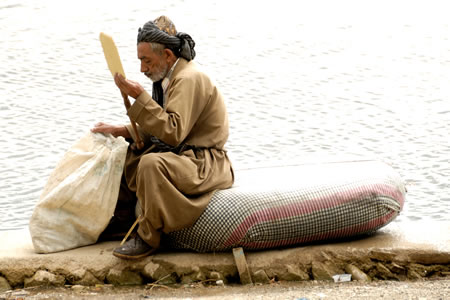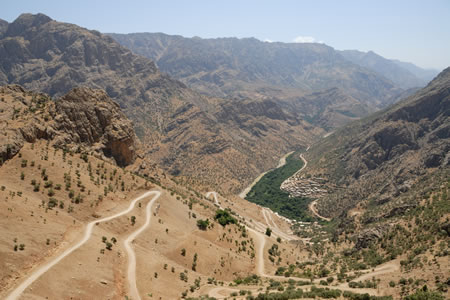

| The spectacular Howraman Valley | |
Kermanshah (Iran), July 1st 2007 |
|
In the central west part of Iran, close to the border with Iraq, you will find the Howraman valley. This valley is located in the most spectacular part of Kurdish Iran, where you can still find villages as they where many years ago. To visit this valley, we first travelled to the city of Sanandaj, the capital city of Kurdish Iran. From Sanandaj, you need to travel more westward to the small city of Marivan, located only 10 kilometres from the Iraqi border. We decided to hire a taxi for one day for the spectacular trip through the Howraman valley, and to finish in the small city of Paveh.
It is 07.00 am and we take a taxi from the centre of Sanandaj to the outskirts where the shared taxi’s leave for Marivan. When we arrive, we can share a taxi with Gafy, who is also travelling to Marivan. Gafy is a Kurdish Iraqi guy who lives in Germany for 6 years, and visits his family in the Kurdish part of Iraq every year. Gafy is very enthusiastic about Iraq and tells us how beautiful the Kurdish part is. After 30 minutes of chatting, he comes with the expected question: “Do you want to travel with me to Iraq”. Ivonne and I look at each other and without further discussion we know the answer: “No, we do not go to Iraq”. Is he mad? It is much to dangerous for foreign people to travel to Iraq. Besides that, Gafy is crossing the border near Marivan, and that is not an official border crossing. We do not want to take the chance to get stuck in Iraq. Gafy tries one more time to convince us, but his chances are zero. Meanwhile we arrive in Marivan and the taxi driver drops us at the outskirts of town. Before we say goodbye to Gafy, we first use him as translator to arrange a taxi for us for the next day to the Howraman valley. Most travel books tell you that you can only enter the valley by four wheel drive vehicle, but the roads are dry, so we try to arrange a Paykan (gas guzzling Iranian car brand of which 2 million cars are made). Ten minutes later everything is settled. A taxi driver will pick us up from the hotel the next morning at 08.00 hours. We decide to spend our afternoon at Lake Zarivar. This lake is located 3 kilometres west of Marivan. Lake Zarivar is beautifully located between rolling mountains. If you look to the other side of the lake, you see the hills that form the border between Iran and Iraq. It is strange to know that this side of the hills is very peaceful, and that it is war on the other side. On most days it is very quite at Lake Zarivar. But not today! It is weekend and that means that many local in the Paykan com this way with their picnic equipment to have a nice day at the lake. The quietness is gone for a part, but is replaced by the cosiness of the picnicking Iranians. |
|
 |
|
An old fisherman is using a "cushion" to sail on Lake Zarivar. |
|
The next day at 8 o’clock we are standing before the hotel with our backpacks. Precisely on time, Fateh (the taxi driver) arrives to pick us up. A couple of minutes later we are on the way to the Howraman valley. In our travel book is mentioned that the paved road goes till Kamala, and that the asphalt end abruptly at the end of the village. De road to the valley is already spectacular. We drive through a narrow canyon and afterwards the road wind up to a high pass from where we have the first great view into the Howraman valley. We Deep in the valley we see the first village, Kamala. By means of hairpins we go down into the valley. The hills as they were in Marivan, are replaced by high and rough mountains. We make s short stop in Kamala to make a stroll through the village. Some old men still wear traditional cloths like the “Kolobal”. This is a browns jacket with some kind of ‘horns’ on their shoulders. The next village where we make a stop is Howraman-at-Takht. This is the biggest and most beautiful village of the valley. The houses are built against a mountain and the roof of one house serve as garden of the house that is built above. In Howraman-at-Takht, Fateh tries to convince us to take the new road to Paveh, in stead of the old (and unpaved) one. There seems to be a new and comfortable road that goes around the valley and which is much better for the Paykan. But that is not what we want. We want the most spectacular road, and that is the road right through the valley. A little bit peevish, Fateh starts his Paykan again and we drive deeper into the valley, leaving the asphalted road behind us. |
|
 |
|
The hairpins of the Howraman Valley. |
|
| The environment becomes more and more spectacular. We drive via hairpin road from pass to pass, and from every pass we have again a beautiful view on the next part of the valley. Sometimes we pass a small village. It is hard to understand why these people decide to live in these very remote villages. In one of the villages, Bulbar, we make a stop for the lunch Of course, they serve Kebab, with bread and yoghurt. This time is also use by the Paykan to cool down a little bit. But so far, the Paykan did his job well. Sometimes we meet some other vehicles on the road. Most of the time these vehicles are 4WD jeeps or small trucks that carry people from one village to another. It is a spectacular road through a beautiful area.
At the end of the day, the Paykan arrives “panting and gasping” in the village of Ura. Ura is located at the end of the valley, and this is the place where the road is asphalted again. Also Fateh is relieved that we made it. From Ura it is another 20 kilometres to our final destination Paveh. We ask Fateh to drop us at a hotel in Paveh. However, Fateh tell us that there is no hotel in Paveh and that he will drop us at his brother where we can spend the night. We learned that day that the definition for brother is everything between a real brother and a vague friend. We decide to see what happened and Fateh steers his car into the outskirts of Paveh. Five minutes later he stops in front of a house. It seems to be the house of Fateh’s sister and we are welcomed with open arms. Before we know we drank our first tea and Ivonne wears a Kurdish dress of one of the daughters. Again, an example of overwhelming hospitality of the Iranians. We had a great evening, and as often, the day was ended by a nice cup of tea. © copyright - Babakoto.eu / 2007 |
|